Abstract
Efforts to represent knowledge effectively have been central to progress in various aspects of medical informatics. These efforts range from relatively simple "electronic textbooks" to fairly sophisticated knowledge-based systems, which function as well as, or even better than, human experts faced with similar problems. Knowledge bases have been developed in many fields, but the relatively limited domains and structured language of medicine, as well as the importance of information in the provision of good medical care, have made research in medical knowledge representation an area of intense activity. This paper reviews representative knowledge bases and knowledge-based systems in medicine: electronic textbooks such as PDQ and the Hepatitis Knowledge Base (HKB), rule-based systems such as MYCIN, causal models (e.g., CASNET), and hypothesis- or frame-based systems, exemplified by PIP and INTERNIST-1. The paper describes the relationships among divergent approaches and provides a sense of current and future trends. It examines problems in knowledge-based systems, particularly in knowledge representation and acquisition, and the responses to these challenges. The latter include the use of domain-independent software shells for constructing knowledge bases, the adaptation and use of previously existing knowledge bases, and multiple uses of the same knowledge base for different purposes.
Full text
PDF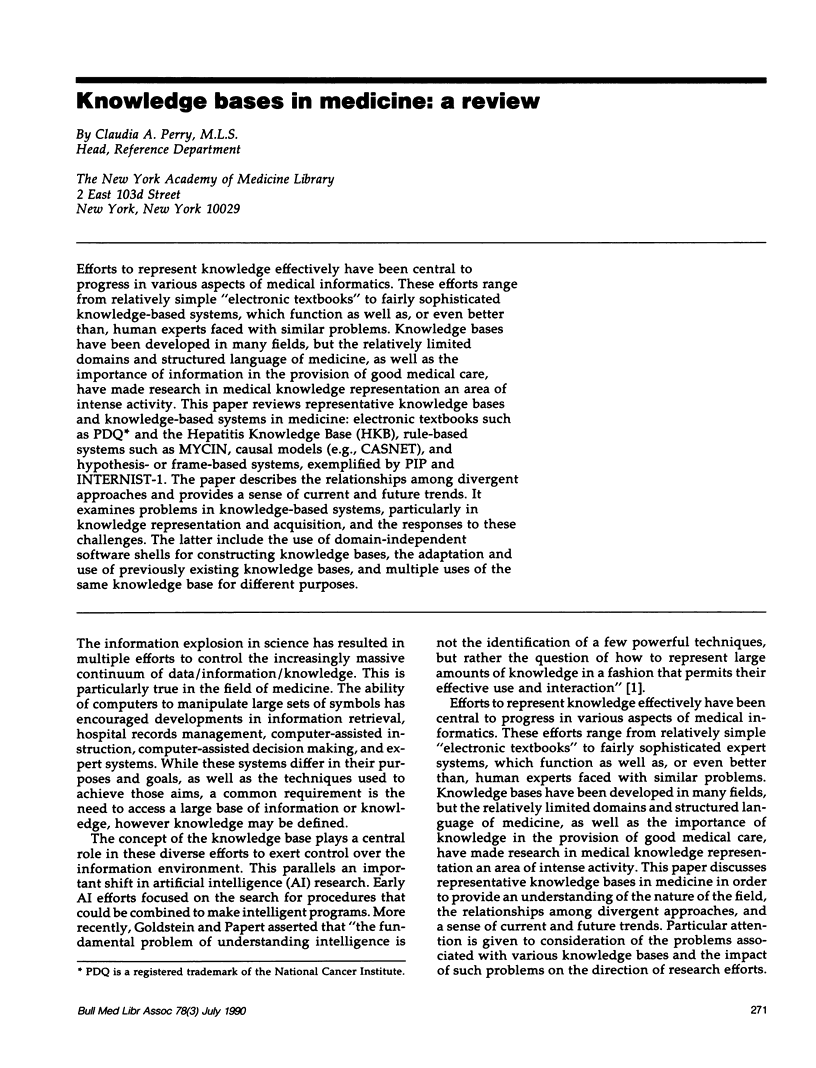
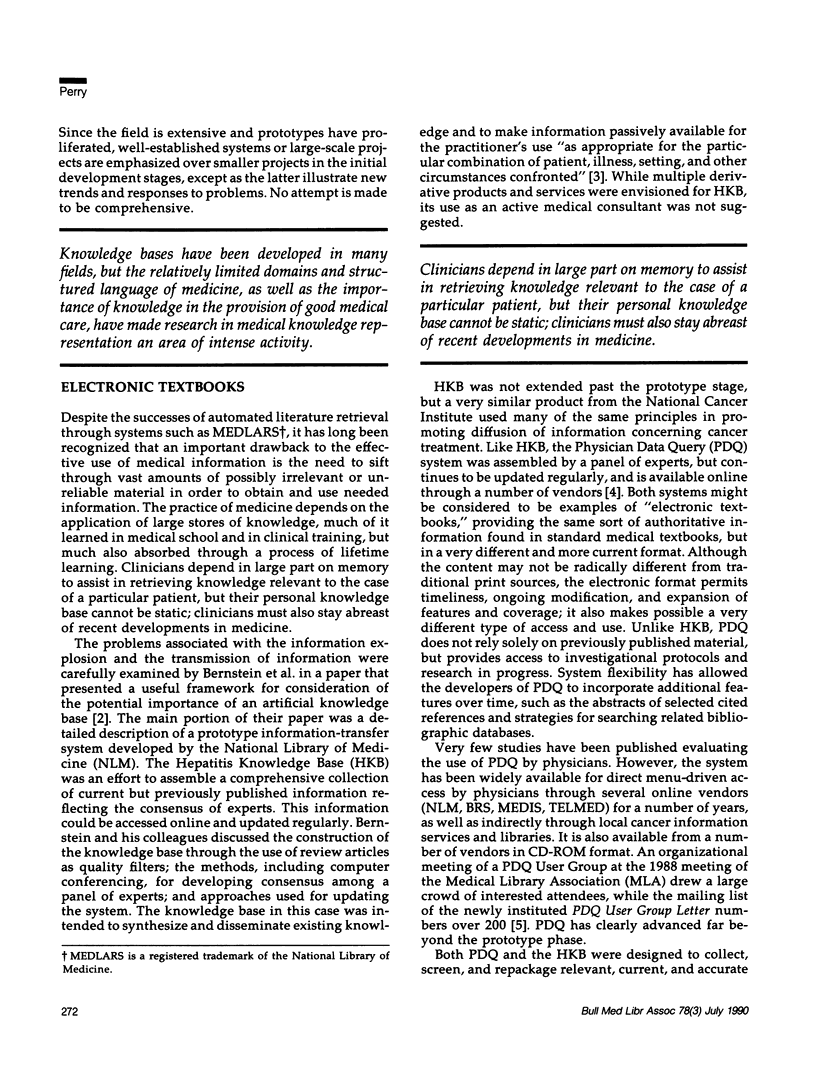
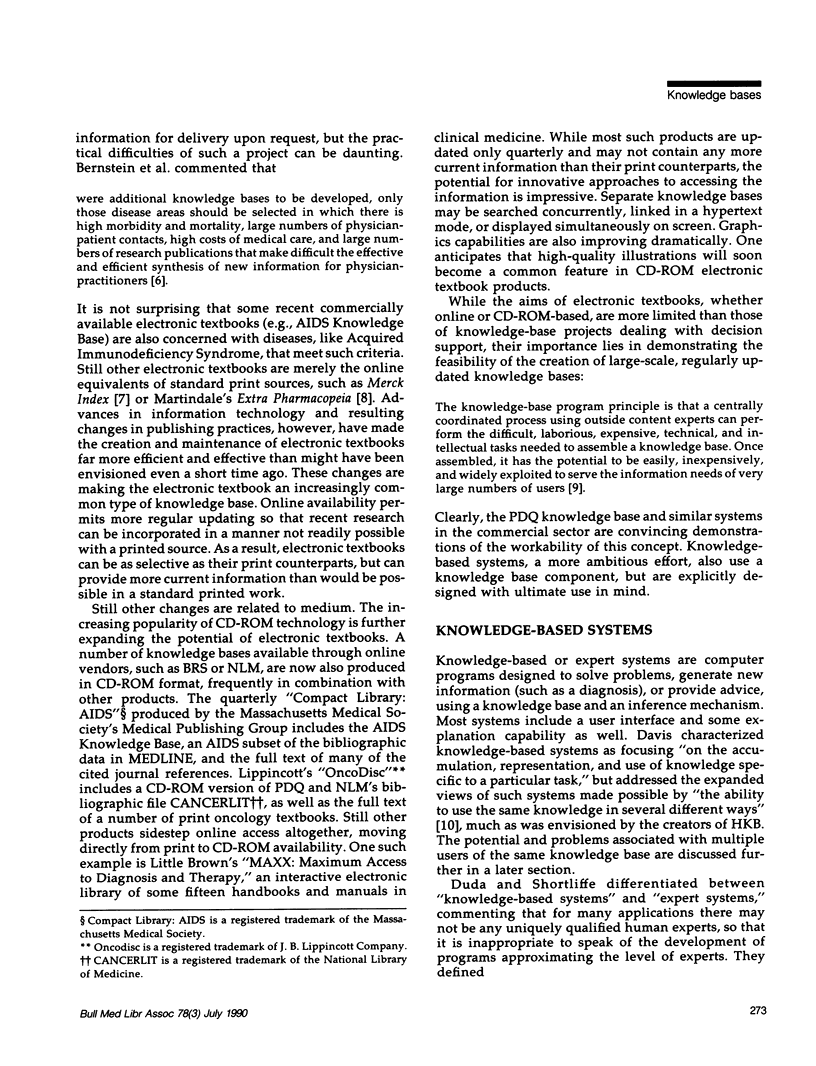
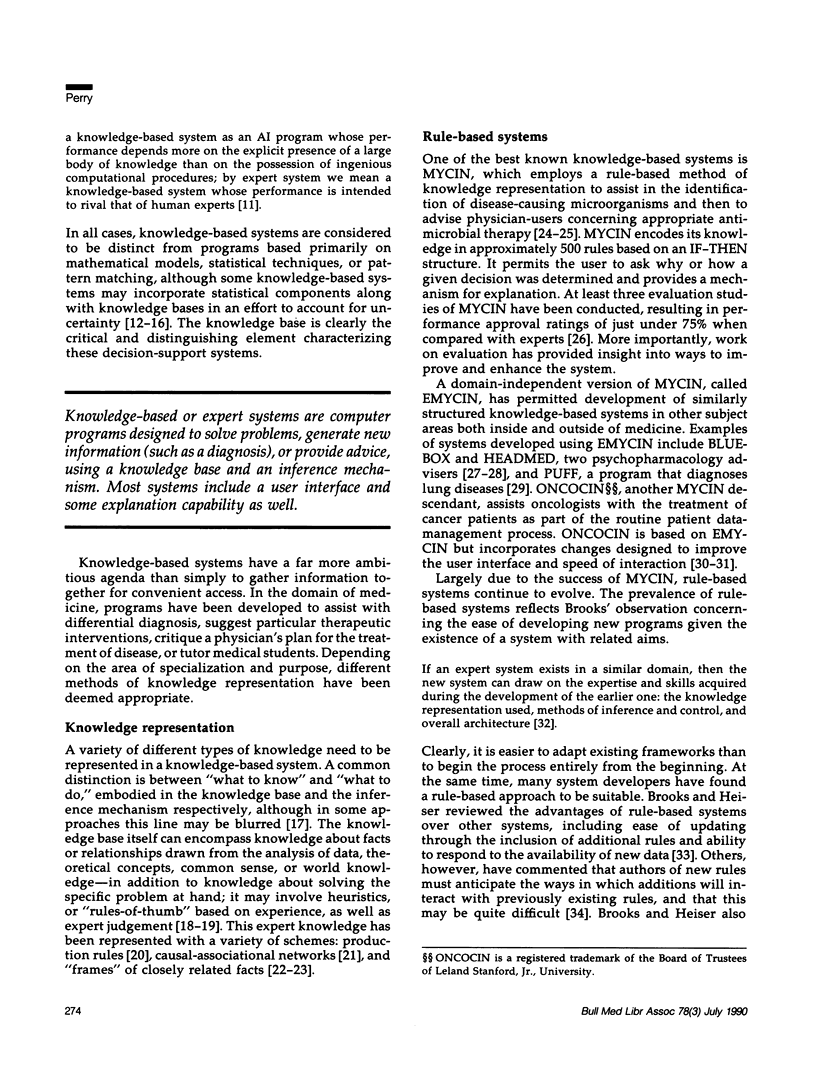
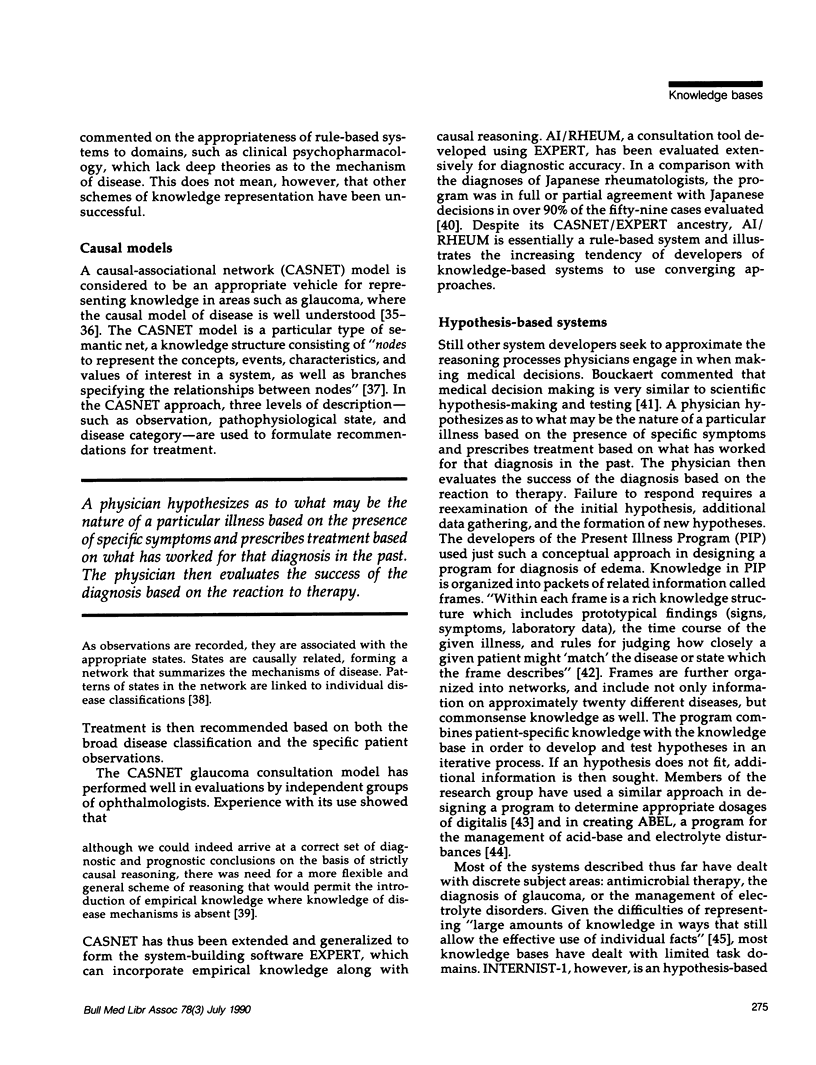
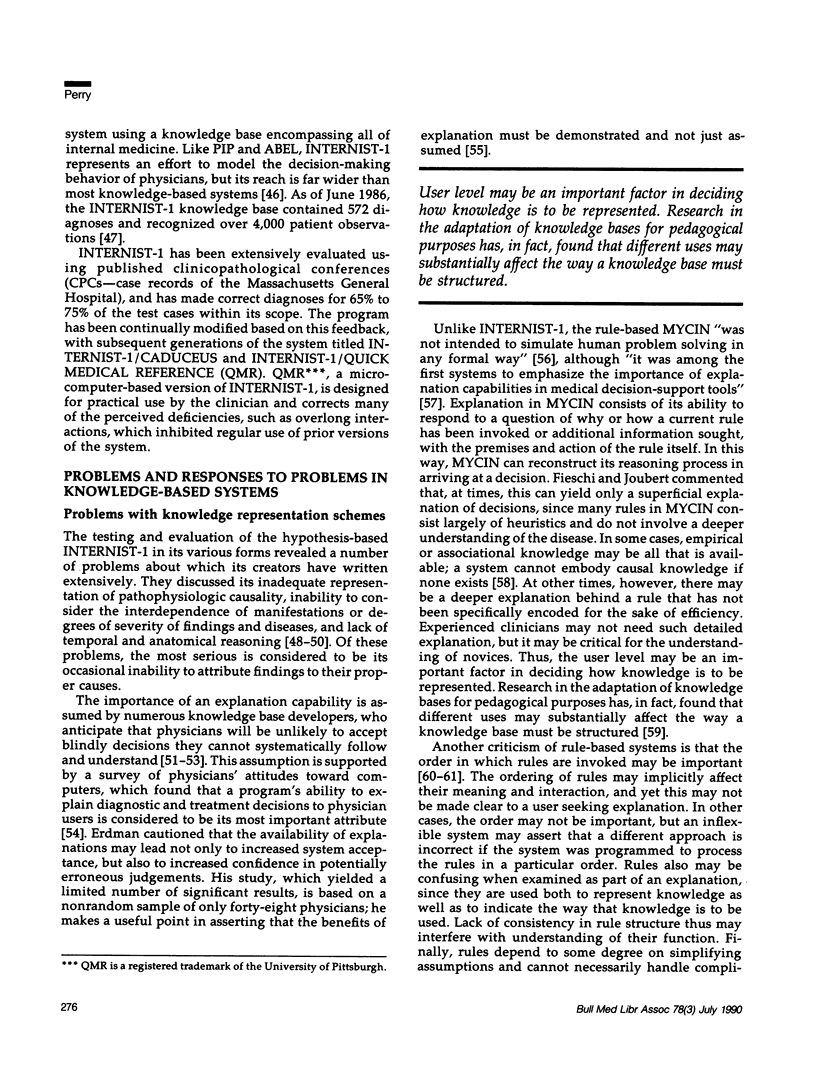
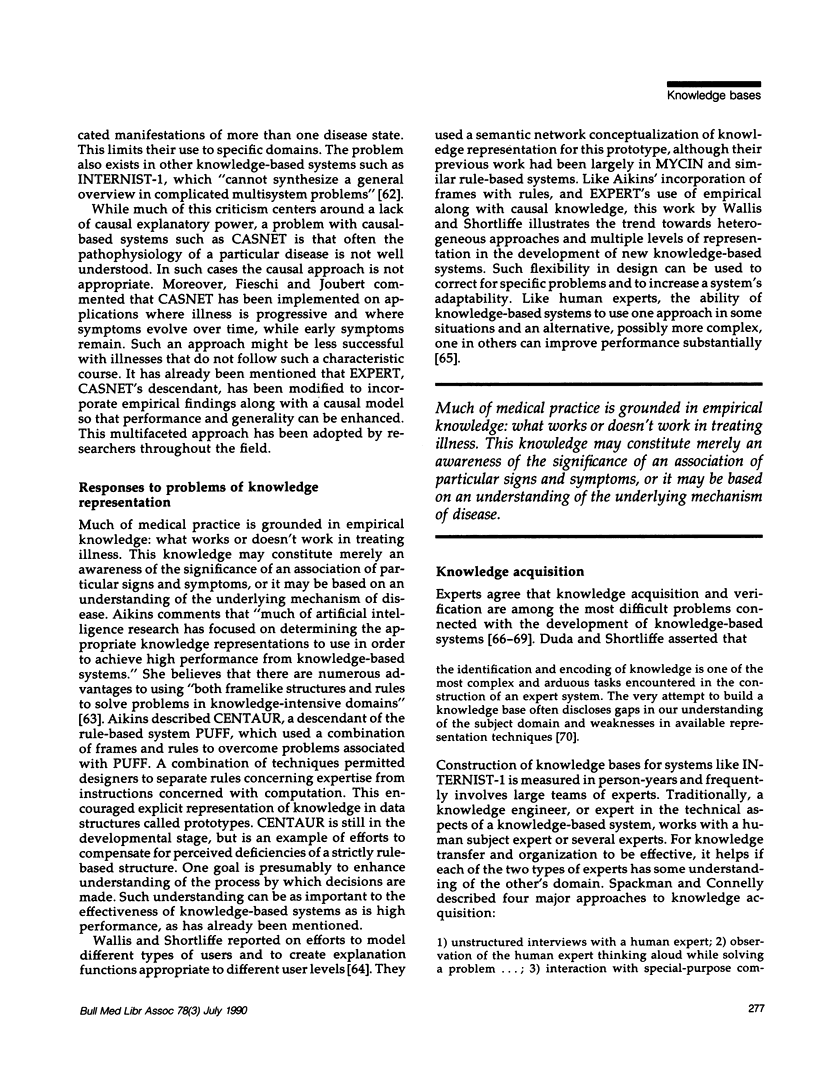
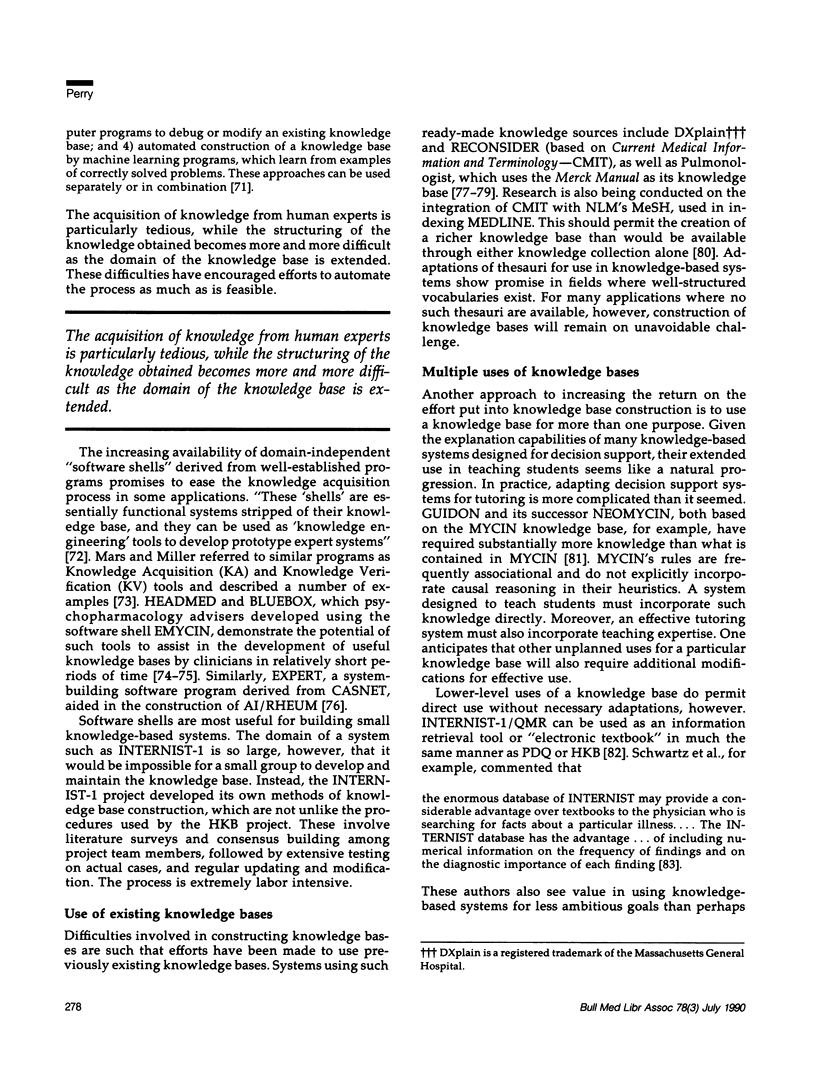
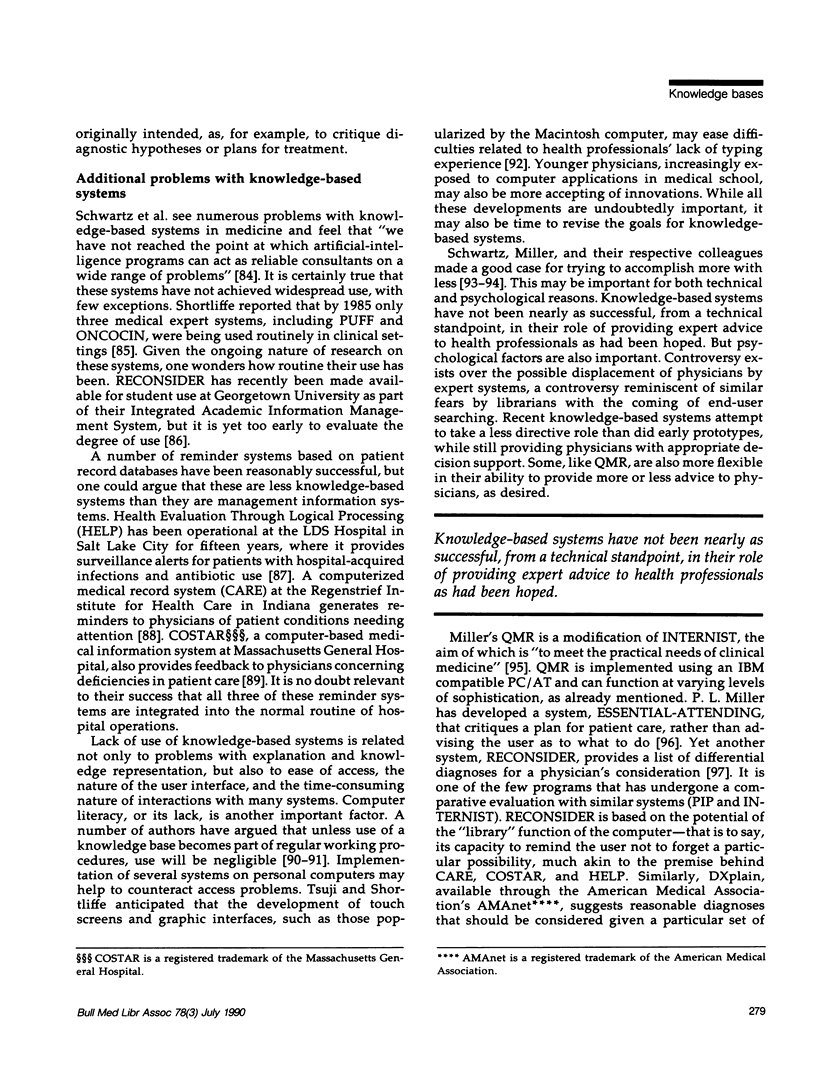
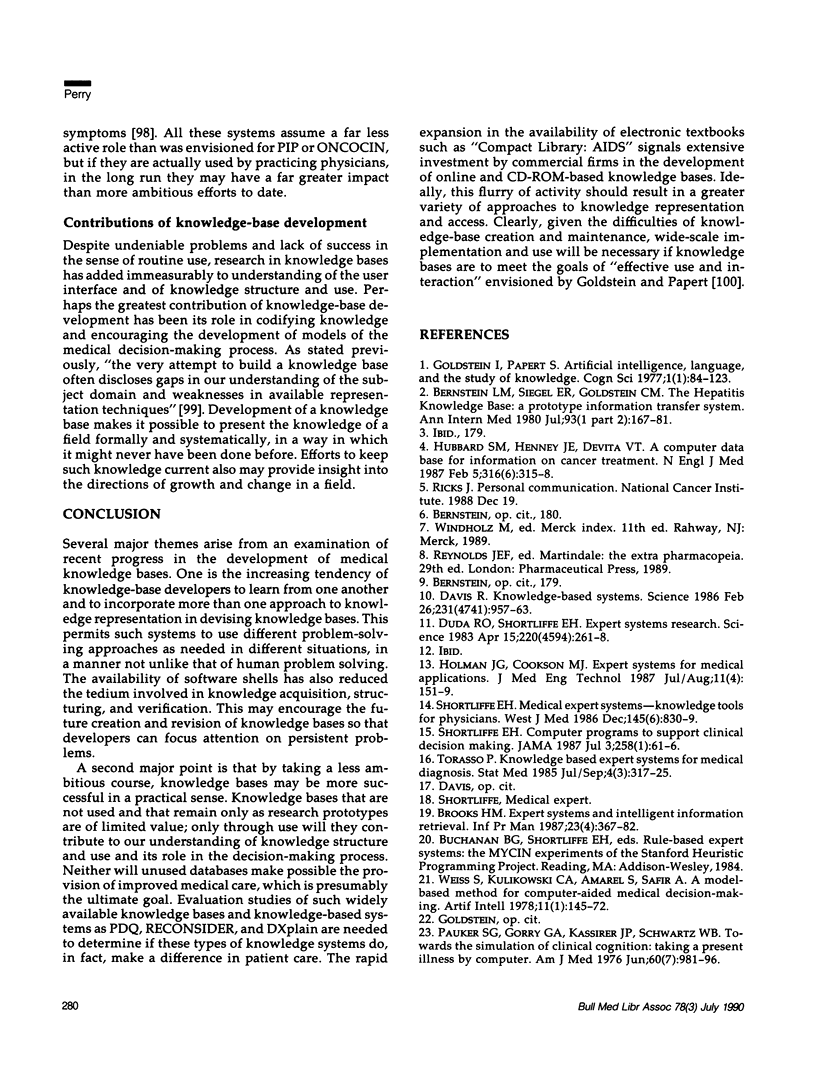
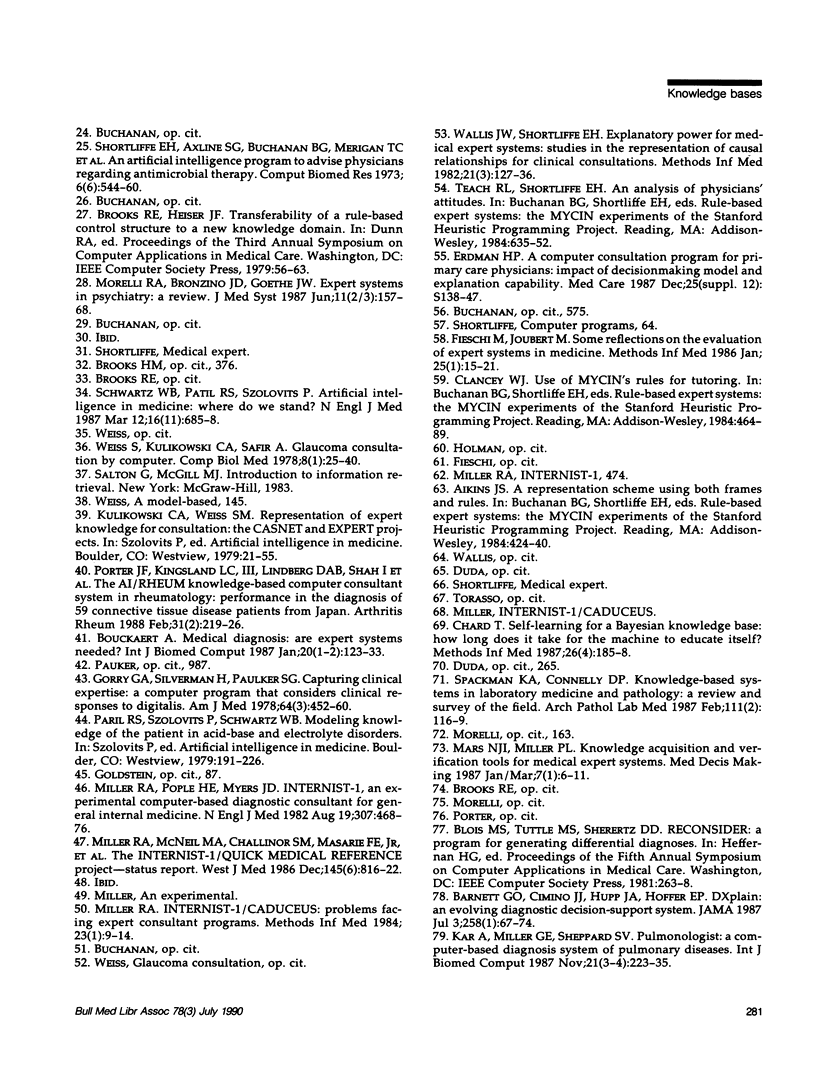
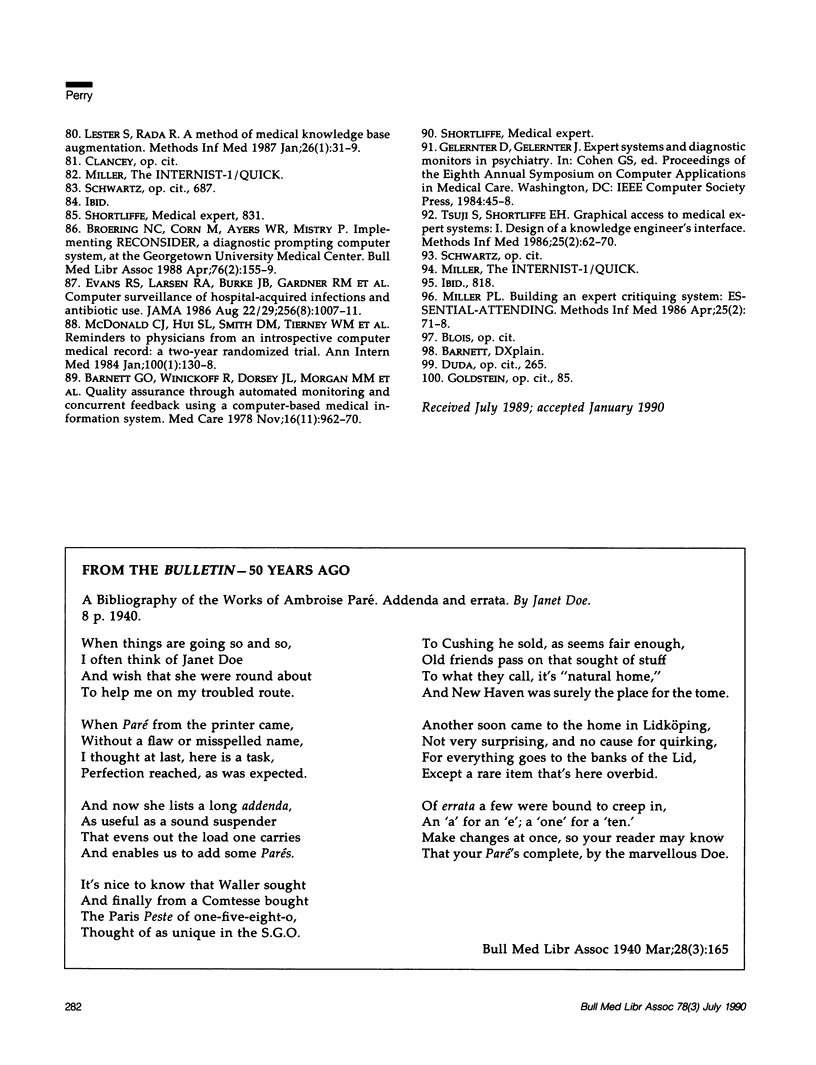
Selected References
These references are in PubMed. This may not be the complete list of references from this article.
- Barnett G. O., Cimino J. J., Hupp J. A., Hoffer E. P. DXplain. An evolving diagnostic decision-support system. JAMA. 1987 Jul 3;258(1):67–74. doi: 10.1001/jama.258.1.67. [DOI] [PubMed] [Google Scholar]
- Barnett G. O., Winickoff R., Dorsey J. L., Morgan M. M., Lurie R. S. Quality assurance through automated monitoring and concurrent feedback using a computer-based medical information system. Med Care. 1978 Nov;16(11):962–970. doi: 10.1097/00005650-197811000-00007. [DOI] [PubMed] [Google Scholar]
- Bouckaert A. Medical diagnosis: are expert systems needed? Int J Biomed Comput. 1987 Jan;20(1-2):123–133. doi: 10.1016/0020-7101(87)90020-1. [DOI] [PubMed] [Google Scholar]
- Broering N. C., Corn M., Ayers W. R., Mistry P. Implementing RECONSIDER, a diagnostic prompting computer system, at the Georgetown University Medical Center. Bull Med Libr Assoc. 1988 Apr;76(2):155–158. [PMC free article] [PubMed] [Google Scholar]
- Chard T. Self-learning for a Bayesian knowledge base: how long does it take for the machine to educate itself? Methods Inf Med. 1987 Oct;26(4):185–188. [PubMed] [Google Scholar]
- Davis R. Knowledge-based systems. Science. 1986 Feb 28;231(4741):957–963. doi: 10.1126/science.231.4741.957. [DOI] [PubMed] [Google Scholar]
- Duda R. O., Shortliffe E. H. Expert Systems Research. Science. 1983 Apr 15;220(4594):261–268. doi: 10.1126/science.6340198. [DOI] [PubMed] [Google Scholar]
- Erdman H. P. A computer consultation program for primary care physicians. Impact of decisionmaking model and explanation capability. Med Care. 1987 Dec;25(12 Suppl):S138–S147. doi: 10.1097/00005650-198712001-00015. [DOI] [PubMed] [Google Scholar]
- Evans R. S., Larsen R. A., Burke J. P., Gardner R. M., Meier F. A., Jacobson J. A., Conti M. T., Jacobson J. T., Hulse R. K. Computer surveillance of hospital-acquired infections and antibiotic use. JAMA. 1986 Aug 22;256(8):1007–1011. [PubMed] [Google Scholar]
- Fieschi M., Joubert M. Some reflections on the evaluation of expert systems in medicine. Methods Inf Med. 1986 Jan;25(1):15–21. [PubMed] [Google Scholar]
- Gorry G. A., Silverman H., Pauker S. G. Capturing clinical expertise. A computer program that considers clinical responses to digitalis. Am J Med. 1978 Mar;64(3):452–460. doi: 10.1016/0002-9343(78)90232-2. [DOI] [PubMed] [Google Scholar]
- Holman J. G., Cookson M. J. Expert systems for medical applications. J Med Eng Technol. 1987 Jul-Aug;11(4):151–159. doi: 10.3109/03091908709008986. [DOI] [PubMed] [Google Scholar]
- Hubbard S. M., Henney J. E., DeVita V. T., Jr A computer data base for information on cancer treatment. N Engl J Med. 1987 Feb 5;316(6):315–318. doi: 10.1056/NEJM198702053160606. [DOI] [PubMed] [Google Scholar]
- Kar A., Miller G. E., Sheppard S. V. PULMONOLOGIST: a computer-based diagnosis system for pulmonary diseases. Int J Biomed Comput. 1987 Nov;21(3-4):223–235. doi: 10.1016/0020-7101(87)90089-4. [DOI] [PubMed] [Google Scholar]
- Lester S., Rada R. A method of medical knowledge base augmentation. Methods Inf Med. 1987 Jan;26(1):31–39. [PubMed] [Google Scholar]
- Mars N. J., Miller P. L. Knowledge acquisition and verification tools for medical expert systems. Med Decis Making. 1987 Jan-Mar;7(1):6–11. doi: 10.1177/0272989X8700700105. [DOI] [PubMed] [Google Scholar]
- McDonald C. J., Hui S. L., Smith D. M., Tierney W. M., Cohen S. J., Weinberger M., McCabe G. P. Reminders to physicians from an introspective computer medical record. A two-year randomized trial. Ann Intern Med. 1984 Jan;100(1):130–138. doi: 10.7326/0003-4819-100-1-130. [DOI] [PubMed] [Google Scholar]
- Miller P. L. Building an expert critiquing system: ESSENTIAL-ATTENDING. Methods Inf Med. 1986 Apr;25(2):71–78. [PubMed] [Google Scholar]
- Miller R. A. INTERNIST-1/CADUCEUS: problems facing expert consultant programs. Methods Inf Med. 1984 Jan;23(1):9–14. [PubMed] [Google Scholar]
- Miller R. A., McNeil M. A., Challinor S. M., Masarie F. E., Jr, Myers J. D. The INTERNIST-1/QUICK MEDICAL REFERENCE project--status report. West J Med. 1986 Dec;145(6):816–822. [PMC free article] [PubMed] [Google Scholar]
- Miller R. A., Pople H. E., Jr, Myers J. D. Internist-1, an experimental computer-based diagnostic consultant for general internal medicine. N Engl J Med. 1982 Aug 19;307(8):468–476. doi: 10.1056/NEJM198208193070803. [DOI] [PubMed] [Google Scholar]
- Morelli R. A., Bronzino J. D., Goethe J. W. Expert systems in psychiatry. A review. J Med Syst. 1987 Jun;11(2-3):157–168. doi: 10.1007/BF00992350. [DOI] [PubMed] [Google Scholar]
- Pauker S. G., Gorry G. A., Kassirer J. P., Schwartz W. B. Towards the simulation of clinical cognition. Taking a present illness by computer. Am J Med. 1976 Jun;60(7):981–996. doi: 10.1016/0002-9343(76)90570-2. [DOI] [PubMed] [Google Scholar]
- Porter J. F., Kingsland L. C., 3rd, Lindberg D. A., Shah I., Benge J. M., Hazelwood S. E., Kay D. R., Homma M., Akizuki M., Takano M. The AI/RHEUM knowledge-based computer consultant system in rheumatology. Performance in the diagnosis of 59 connective tissue disease patients from Japan. Arthritis Rheum. 1988 Feb;31(2):219–226. doi: 10.1002/art.1780310210. [DOI] [PubMed] [Google Scholar]
- Schwartz W. B., Patil R. S., Szolovits P. Artificial intelligence in medicine. Where do we stand? N Engl J Med. 1987 Mar 12;316(11):685–688. doi: 10.1056/NEJM198703123161109. [DOI] [PubMed] [Google Scholar]
- Shortliffe E. H., Axline S. G., Buchanan B. G., Merigan T. C., Cohen S. N. An artificial intelligence program to advise physicians regarding antimicrobial therapy. Comput Biomed Res. 1973 Dec;6(6):544–560. doi: 10.1016/0010-4809(73)90029-3. [DOI] [PubMed] [Google Scholar]
- Shortliffe E. H. Computer programs to support clinical decision making. JAMA. 1987 Jul 3;258(1):61–66. [PubMed] [Google Scholar]
- Shortliffe E. H. Medical expert systems--knowledge tools for physicians. West J Med. 1986 Dec;145(6):830–839. [PMC free article] [PubMed] [Google Scholar]
- Spackman K. A., Connelly D. P. Knowledge-based systems in laboratory medicine and pathology. A review and survey of the field. Arch Pathol Lab Med. 1987 Feb;111(2):116–119. [PubMed] [Google Scholar]
- Torasso P. Knowledge based expert systems for medical diagnosis. Stat Med. 1985 Jul-Sep;4(3):317–325. doi: 10.1002/sim.4780040311. [DOI] [PubMed] [Google Scholar]
- Tsuji S., Shortliffe E. H. Graphical access to medical expert systems: I. Design of a knowledge engineer's interface. Methods Inf Med. 1986 Apr;25(2):62–70. [PubMed] [Google Scholar]
- Wallis J. W., Shortliffe E. H. Explanatory power for medical expert systems: studies in the representation of causal relationships for clinical consultations. Methods Inf Med. 1982 Jul;21(3):127–136. [PubMed] [Google Scholar]
- Weiss S., Kulikowski C. A., Safir A. Glaucoma consultation by computer. Comput Biol Med. 1978 Jan;8(1):25–40. doi: 10.1016/0010-4825(78)90011-2. [DOI] [PubMed] [Google Scholar]


